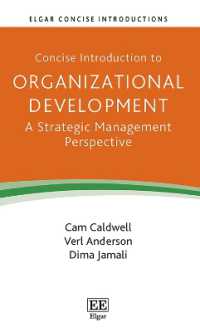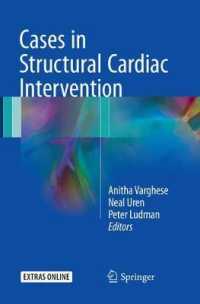- ホーム
- > 洋書
- > 英文書
- > Science / Mathematics
Full Description
Additive manufacturing (AM) is a manufacturing process that has emerged as a viable technology for the production of engineering components. The aspects associated with additive manufacturing, such as less material wastage, ease of manufacturing, less human involvement, fewer tool and fixture requirements, and less post-processing, make the process sustainable for industrial use. Further, this new technology has led to highly optimized product characteristics and functional aspects. This textbook introduces the basics of this new additive manufacturing technology to individuals who will be involved in the grand spectrum of manufacturing finished products.
Fundamentals of Additive Manufacturing Technology: Principles, Technologies, and Applications provides knowledge and insight into various aspects of AM and deals with the basics, categories, materials, tooling, and equipment used. It presents a classified and complete description of the most common and recently developed additive manufacturing methods with applications, solved examples, and review questions. This textbook also emphasizes the fundamentals of the process, its capabilities, typical applications, advantages, and limitations, and also discusses the challenges, needs, and general recommendations for additive manufacturing.
This fundamental textbook is written specifically for undergraduates in manufacturing, mechanical, industrial, and materials engineering disciplines for courses in manufacturing technology taught in engineering colleges and institutions all over the world. It also covers the needs of production and manufacturing engineers and technologists participating in related industries. Additionally, the textbook can be used by students in other disciplines concerned with design and manufacturing, such as automotive, biomedical, and aerospace engineering.
Contents
1. Introduction to Additive Manufacturing. 2. Software Aspects for Additive Manufacturing. 3. Basic Additive Manufacturing Techniques. 4. Technologies of Additive Manufacturing of Polymers and Composites. 5. Technologies of Additive Manufacturing of Metallic Materials. 6. Technologies for Additive Manufacturing of Ceramics (AMC). 7. Feedstock Materials for Additive Manufacturing Processes. 8. Post-Processing Techniques in Additive Manufacturing Processes. 9. Design for Additive Manufacturing. 10. Impact of Additive Manufacturing on Conventional Manufacturing Processes. 11. Manufacturing Cost of Additive Manufacturing. 12. Environmental and Health Impacts of Additive Manufacturing. 13. Fields of Application of Additive Manufacturing. 14. Additive Manufacturing Characterization, Challenges and Needs, Future Trends and Final Recommendations. 15. Additive Manufacturing Case Studies.








